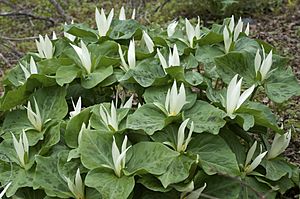Giant white wakerobin facts for kids
Quick facts for kids Giant white wakerobin |
|
|---|---|
 |
|
| Mendocino County, California | |
| Conservation status | |
| Scientific classification | |
| Genus: |
Trillium
|
| Species: |
albidum
|
| Synonyms | |
|
|
Trillium albidum, also known as giant white wakerobin or sweet trillium, is a type of flowering plant. It belongs to the Melanthiaceae family. This plant grows only in the western United States. You can find it from central California up through Oregon to Washington. It likes moist places in forests, among bushes, and along riverbanks.
For a long time, people sometimes confused Trillium albidum with another plant called T. chloropetalum. This was especially true near the San Francisco Bay. Sometimes, these two plants might even mix their genes, making new plants that are a bit of both.
About Its Name and Types
The scientific name for this plant is Trillium albidum. But there are also two main types, or subspecies, that scientists recognize:
- Trillium albidum subsp. albidum
- Trillium albidum subsp. parviflorum
These two subspecies look a bit different. Trillium albidum subsp. parviflorum is usually smaller. Its stem is only about 17 to 30 cm (6.5 to 12 in) tall. Its flower petals are also shorter and narrower, about 2.2 to 4.5 cm (1 to 2 in) long. This is about half the size of the albidum subspecies.
Scientists have studied these plants a lot. Some think T. parviflorum is its own species. Others think it is just a subspecies of T. albidum. There is also evidence that T. albidum subsp. parviflorum might be more closely related to the Yellow trillium (T. luteum) than to its own albidum subspecies.
Geographically, T. albidum subsp. albidum grows from northern California to central Oregon. T. albidum subsp. parviflorum is found in northwestern Oregon and southwestern Washington. Where their areas overlap, it can be tricky to tell them apart just by looking at them.
What It Looks Like
The giant white wakerobin is a perennial plant. This means it lives for many years. It grows from underground stems called rhizomes. From these rhizomes, a stem called a scape grows up to 22 to 58 cm (8.5 to 23 in) tall.
Around the stem, there are three large, leaf-like parts called bracts. They are wide and oval-shaped, about 10 to 20 cm (4 to 8 in) long. These bracts are green and often have faint brown or dark green spots. These spots might fade as the plant gets older.
Each stem usually has one flower. This flower sits right on top of the bracts. The flower smells nice and has three green sepals. It also has three white petals. Sometimes, these petals can have a pink or purple tint. They are quite large, measuring 4.8 to 8 cm (2 to 3 in) long.
Trillium albidum is special because it is the only Trillium species with white flowers that sit directly on the plant without a stalk. In most places, if you see a Trillium with white flowers that look like this, it is probably Trillium albidum. However, in the San Francisco Bay Area, another Trillium species can also have white flowers. In that case, you can tell T. albidum apart by looking at its reproductive parts, which are white or pale green.
This plant is so beautiful that it has won an Award of Garden Merit. This award is given to plants that are excellent for growing in gardens.
Life Cycle
Trillium albidum usually blooms in the spring. This happens from mid-March to early May. In California, you might see its flowers from February to June.
Like other Trillium plants, it grows in stages. First, it has a single leaf. Then, it grows into a young plant with three leaves. After several years of growing, it finally reaches its adult stage. At this point, it will have three leaves and start to produce flowers. This plant can live for many, many years.


